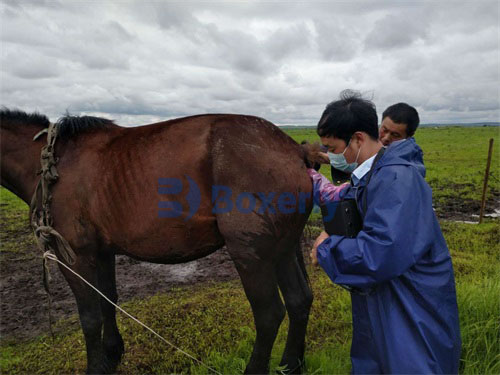As a livestock veterinarian working across different countries, I have witnessed firsthand how veterinary reproductive technologies differ across cultures—and how ultrasonography (ultrasound) has become an indispensable tool for aligning pregnancy diagnosis with precision artificial insemination (AI). In countries like Japan and the U.S., ultrasound is standard practice; in other nations, blood-based tests may dominate due to resource constraints. Însă, across regions, professionals share a common understanding: timing is everything. This article explores how ultrasound can optimize AI timing, drawing on global expertise to enhance conception rates and reproductive efficiency.

Why Timing Matters in Artificial Insemination
Successful AI depends on inseminating cows close to ovulation—typically 12 spre 24 hours after detected estrus. The lifespan of sperm and the oocyte sets a narrow fertility window. De exemplu, studies in Holstein heifers using activity monitors showed that AI between 9 și 32 hours after estrus onset maximizes conception rates. Similarly, precise timing guided by hormone protocols leads to better outcomes than relying on observation of heat alone.
Ultrasound adds another layer of precision. It enables not only confirmation of pregnancy but also monitoring of ovarian structures—like follicle size and corpus luteum functional status—thus informing when to administer hormone treatments and inseminate.
How Ultrasound Shapes AI Protocols
Synchronizing Ovulation
Timed AI protocols (TAI) such as Ovsynch—administering GnRH, PGF₂α, and AI at fixed intervals—have improved AI success globally. Însă, initiating TAI without knowing the cow’s ovarian status can misalign ovulation in ~15% of cases. To mitigate this, some farms perform an ultrasound first to ensure a functional corpus luteum (CL) ≥ 18 mm. One Japanese study on Japanese Black cows showed that adding pre‑TAI ultrasound and using PGF₂α→GnRH‑AI resulted in 60% pregnancy rates—significantly higher than spontaneous estrus-AI controls.
Early Pregnancy Diagnosis
Under typical farm conditions, transrectal ultrasound can confirm pregnancy as early as 26–30 days post-AI, with ≥ 98% accuracy when performed by trained operators. Early detection allows prompt rebreeding of non-pregnant cows and culling decisions—critical for operational efficiency.
Embryonic Viability, Twins, and Sexing
Ultrasound also reveals fetal heartbeats around day 26–28, enabling viability checks. It identifies twins and ovarian cysts, and can even determine fetal sex between days 55–60—a valuable tool in dairy and beef operations for planning and selection.

Integrating Ultrasound with AI Timelines
Typical Farm Workflow
-
Estrus synchronization—using hormone regimens.
-
Ultrasound scan ~day 0–2 to confirm CL presence and size (De ex., ≥ 18 mm).
-
Administer PGF₂α if CL functional; GnRH ~56 h later; AI at 16–20 h post-GnRH.
-
Confirm pregnancy via ultrasound ~day 26–30 post-AI.
-
Second check at day 60 to stabilize diagnosis and detect embryonic loss (~15%).
-
Fetal sexing between days 55–60 if desired.
How It Compares Globally
-
Statele Unite / Europe: Widespread TAI use combined with transrectal ultrasound ensures high pregnancy rates and efficient herd management.
-
Buffalo production (De ex., India, Egypt): TAI with ultrasound and Doppler supports accurate ovulation timing without relying on estrus signs.
-
Japan: Advanced use of portable ultrasound and emerging AI tools (De ex., AI‑driven uterine‑opening imaging devices) predict optimal insemination timing, assisting less experienced technicians.
Benefits of Ultrasound‑Guided AI
| Advantage | Description |
|---|---|
| Objective ovarian assessment | Ensures CL present—reduces mistimed hormone protocols |
| Detectarea precoce a sarcinii | Enables prompt management of open cows |
| Innovation-friendly | Integration with AI, omics technologies enhances precision |
| Multi-diagnostic | Reveals twins, fetal viability, sex, and reproductive issues |
Challenges and Considerations
-
Training: Ultrasound accuracy depends on operator skill. Inexperienced users may misdiagnose early pregnancies or ovarian structures.
-
Cost and equipment: Portable ultrasound devices cost more than visual or hormone tests. Însă, per-cow cost may be lower when large herds are involved.
-
AI accuracy: Early fetal loss can follow positive pregnancy diagnoses (~15%). A follow-up scan around day 60 helps confirm viability.
Future Directions
Emerging technologies promise to make ultrasound‑guided AI even more effective:
-
AI-driven image analysis: Systems using machine learning to read ultrasound images and predict pregnancy probability (De ex., Japanese uterine-opening imaging tools showed 76% accuracy).
-
Omics integration: Genomics, proteomics, and metabolomics research is starting to identify biomarkers that could predict fertility and ideal AI timing.
-
Portable Doppler ultrasound: Enhances early CL and pregnancy assessment before fetal visibility.
-
Remote AI protocols: Combining GPS-enabled estrus monitors with real-time ultrasound may allow remote reproductive management and better service in low-resource regions.
Concluzie
Veterinary ultrasound is not just a diagnostic tool; it’s a precision instrument that strengthens AI programs. By confirming ovarian status, diagnosing pregnancies early, and supporting timely hormone administration, ultrasound supports global livestock production. While high-quality results demand training and investment, the payoff—in improved conception rates, herd uniformity, and economic returns—is real.
From Japanese Black cattle to Holstein dairy herds, from U.S. beef ranches to buffalo operations in Asia, ultrasound-guided AI represents a reproductive revolution—where timing transforms success, and technology enables veterinarians and farmers to manage reproduction with greater confidence and efficiency.

References
-
Osawa T. Validation of a novel timed artificial insemination protocol in beef cows using ultrasonography (2018). PMCID: PMC5902898. https://www.ncbi.nlm.nih.gov/pmc/articles/PMC5902898/
-
Beef and Forage Cattle Genomics, Pregnancy Diagnosis in Beef Cattle (2023). UT Beef. https://utbeef.tennessee.edu/cattle-genomics-pregnancy-diagnosis-in-beef-cattle/
-
NDSU Agriculture, Options for Pregnancy Diagnosis in Beef Cattle (2024). https://www.ndsu.edu/agriculture/ag-hub/ag-topics/livestock/beef/production/options-pregnancy-diagnosis-beef-cattle
-
IMV Technologies, Use of Ultrasound Scanning Technique – Bovine (2022). https://www.imv-technologies.com/academy/use-of-ultrasound-scanning-technique-bovine
-
UF IFAS Extension, Practical Uses for Ultrasound in Managing Beef Cattle Reproduction (2022). https://edis.ifas.ufl.edu/publication/AN113
-
Frontiers Vet Sci, Fixed-time artificial insemination technology in buffaloes: a review (2025). https://www.frontiersin.org/journals/veterinary-science/articles/10.3389/fvets.2025.1586609/full
-
Frontiers Animal Sci, Designing diagnostic method to predict optimal artificial insemination timing in cows using AI (2024). https://www.frontiersin.org/journals/animal-science/articles/10.3389/fanim.2024.1399434/full
-
MDPI, Advances in Timed Artificial Insemination: Integrating Omics (2025). https://www.mdpi.com/2076-2615/15/6/816
-
Vet Times, Ultrasound versus milk hormone test (Livestock ultrasound article). https://www.vettimes.com/news/vets/livestock/ultrasound-versus-milk-hormone-test